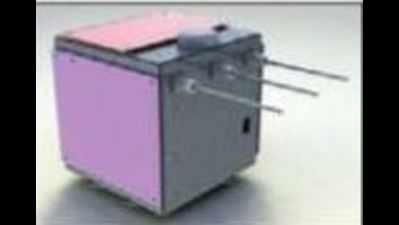- News
- City News
- mumbai News
- Isro to finally launch IIT-B's satellite from Sriharikota space centre in September
Trending
This story is from August 2, 2016
Isro to finally launch IIT-B's satellite from Sriharikota space centre in September
The institute's 10kg student satellite, Pratham, will be launched by Isro's four-stage Polar Satellite Launch Vehicle (PSLV) at the Satish Dhawan Space Centre, Sriharikota in September.

The institute's 10kg student satellite, Pratham, will be launched by Isro's four-stage Polar Satellite Launch Vehicle (PSLV) at the Satish Dhawan Space Centre, Sriharikota in September.
MUMBAI: IIT-B's starry dreams will finally take off next month, after a nine-year wait.
The institute's 10kg student satellite, Pratham, will be launched by Isro's four-stage Polar Satellite Launch Vehicle (PSLV) at the Satish Dhawan Space Centre, Sriharikota in September.
Pratham will piggy back with Isro's main satellite, ScatSat, and few other satellites.Pratham, first conceived in 2007, was dogged by delays for a variety of reasons, upsetting its launch schedule.
On Monday, Pratham project manager Ratnesh Mishra, a final year IIT-B aerospace student, said that the satellite was currently at the clean room of the Isro Satellite Centre in Bengalaru. "Only the exact launch date has to be finalized," he said. This will be an Isro decision.
He said a ground station will be set up at IIT and another at Atharva College in Malad to track Pratham. A few days before the take-off, an eight-member Pratham team will be positioned at Sriharikota for the pre-launch activities, he added.
According to institute officials, the objective of the Pratham project is to make IIT-B a centre for advancement of satellite and space technology.
The institute's 10kg student satellite, Pratham, will be launched by Isro's four-stage Polar Satellite Launch Vehicle (PSLV) at the Satish Dhawan Space Centre, Sriharikota in September.
Pratham will piggy back with Isro's main satellite, ScatSat, and few other satellites.Pratham, first conceived in 2007, was dogged by delays for a variety of reasons, upsetting its launch schedule.
On Monday, Pratham project manager Ratnesh Mishra, a final year IIT-B aerospace student, said that the satellite was currently at the clean room of the Isro Satellite Centre in Bengalaru. "Only the exact launch date has to be finalized," he said. This will be an Isro decision.
Mishra said that with a four-month mission span, the main role of the satellite, which will be placed at an altitude of 720 km, will be measurement of "electron count". This will be useful for scientific studies, correcting errors in communication like the GPS and will also help in tsunami warnings. The total cost of the project is about Rs 1.5 crore.
He said a ground station will be set up at IIT and another at Atharva College in Malad to track Pratham. A few days before the take-off, an eight-member Pratham team will be positioned at Sriharikota for the pre-launch activities, he added.
According to institute officials, the objective of the Pratham project is to make IIT-B a centre for advancement of satellite and space technology.
End of Article
FOLLOW US ON SOCIAL MEDIA










